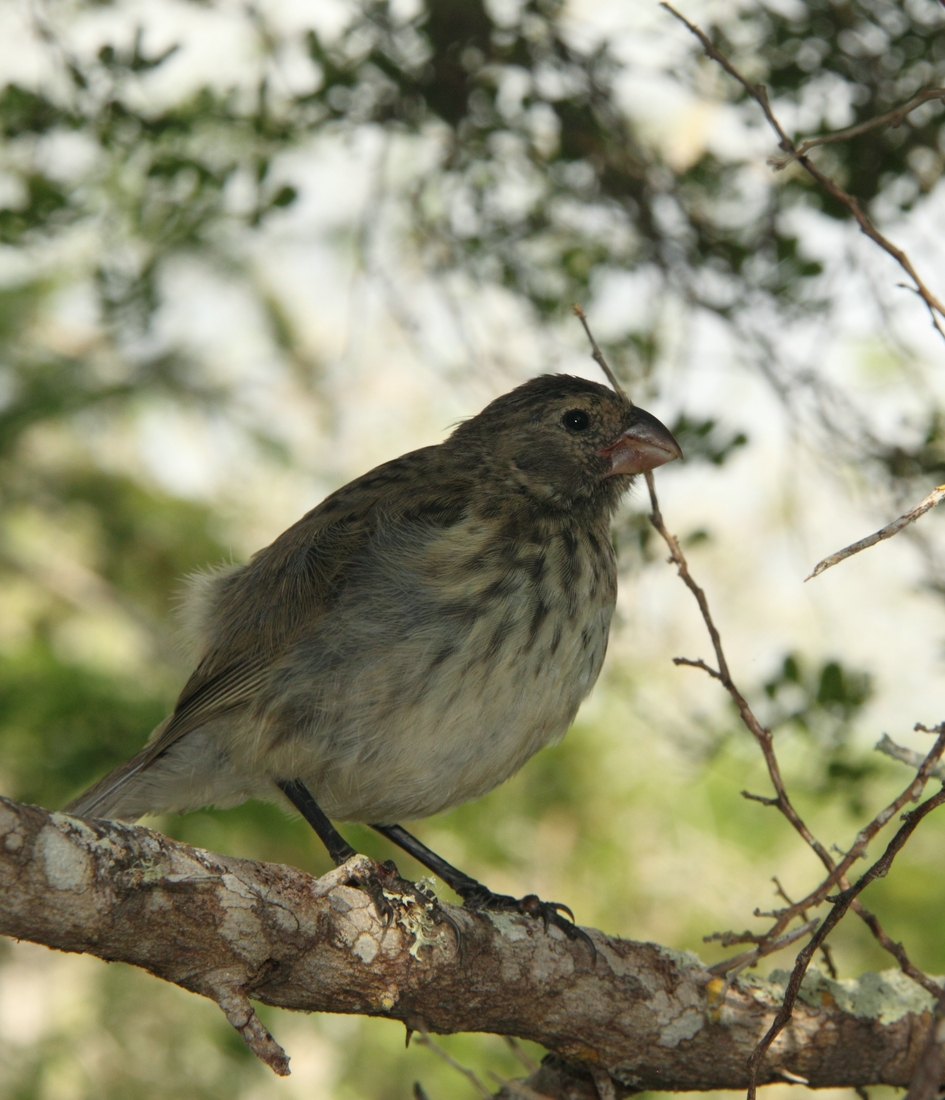Galapagos Species Database
The Galapagos Species Database shares the information about the species from our Natural History Collections.
Platyspiza crassirostris
Pinzón vegetariano, Vegetarian finch




Threats The main threat is probably introduced diseases and when populations are important there, the management of the agricultural areas (pesticide use, remaining forests etc).
Domain
Eukaryota
Kingdom
Animalia
Phylum
Chordata
Class
Aves
Order
Passeriformes
Family
Thraupidae
Genus
Platyspiza
Species
crassirostris
Taxon category: Accepted
Syn.: Camarhynchus crassirostris Gould, 1837; Camarhynchus variegatus (Sclater & Salvin, 1870).
Taxon origin: Endemic
Habitat preferences: This species occurs on all the main islands that support highland vegetation, however it does not occur in the humid forest area but prefers the transition zone and lower agricultural zone.
Feeding preferences: Mainly feeds in trees on soft seeds, buds, blossoms, fruits and leaves but also occasionally on the ground on herbaceous leaves and fallen fruits.
Trophic role: Herbivorous
Reproductive biology: Male displays in front of a dome shape nest. Once chosen, the pair either use this nest – or build a new one. Only females are incubating (two to three eggs), both feed the chicks. Fledglings stay for up to 6 weeks with a parent, either with the male while the female starts a new clutch, or, one with the female and the other with the male.
Distribution: All islands, except Santa Fe, Baltra, Seymour, Darwin, Wolf, Genovesa, Espanola.
- Wiedenfeld, D.A. (2006) Aves, the Galapagos Islands, Ecuador. Check List 2006 2(2): 1-27.
- Jiménez-Uzcátegui, G. Milstead, B., Márquez, C., Zabala, J., Buitrón, P., Llerena, A., et al. (2007) Galapagos vertebrates: endangered status and conservation actions. Galapagos Report 2006–2007. Charles Darwin Foundation, Puerto Ayora, p. 104–110.
- Harris, M.P. (1973) The Galápagos avifauna. Condor 75(3): 265-278.
- Salvin, O. (1876) On the avifauna of the Galápagos Archipelago. Transactions of the Zoological Society of London 9: 447-510.
- Castro, I. Phillips, A. (1996) A Guide to the Birds of the Galapagos Islands. Christopher Helm Publishers Ltd., London.
- Swarth, H.S. (1931) The Avifauna of the Galapagos Islands. Occ. Pap. Calif. Acad. Sci. 18: 1-299.
- Kleindorfer, S. Dudaniec, R.Y. (2006) Increasing prevalence of avian poxvirus in Darwin’s finches and its effect on male pairing success. Journal of Avian Biology 37: 69-76.
- Jiménez-Uzcátegui, G. Betancourt, F. (2008) Avifauna vs automotores. Informe Galápagos 2007-2008. FCD, PNG & INGALA. Puerto Ayora, Ecuador. p. 111–114.
- Bisconti, M. Landini, W., Bianucci, G., Cantalamessa, G., Carnevale, G. Ragaini, L. & Valleri, G. (2001) Biogeographic relationships of the Galapagos terrestrial biota: parsimony analyses of endemicity based on reptiles, land birds and Scalesia land plants. J. Biogeogr. 28: 495-510.
- Donohue, K. (2011) Darwin's Finches: Readings in the Evolution of a Scientific Paradigm University of Chicago Press, Chicago, 492 pp.
- Grant, P.R. Grant, B.R. (1987) Interacciones entre plantas y animales: consumo de semillas por los Pinzones de Darwin. Memorias. Investigación Botánica y Manejo en Galápagos. Pg.199-209
- Dvorak, M. Fessl, B., Nemeth, E., Kleindorfer, S.M., & Tebbich, S. (2012) Distribution and abundance of Darwin ́s Finches and other land birds on Santa Cruz Island Galapagos: evidence for declining populations. Oryx 46:78-86
- Dvorak, M. Vargas, H., Fessl, B. & Tebbich, B. (2004) On the verge of extinction: a survey of the mangrove finch Cactospiza heliobates and its habitat on the Galápagos islands. Oryx 38:1-9.
- Farrington, H. Petren, K. (2011) A century of genetic change and metapopulation dynamics in the Galápagos warbler finches (Certhidea). Evolution 65:3148-3161.
- Petren, K. Grant, B. & Grant, P. (1999) A phylogeny of Darwin's finches based on microsatellite DNA length variation. Proceedings of the Royal Society of London Series B-Biological Sciences 266:321-329.
- Sato, A. O'hUigin, C., Figueroa, F., Grant, P., Grant, B., Tichy, H. & Klein, J. (1999) Phylogeny of Darwin's finches as revealed by mtDNA sequences. Proceedings of the National Academy of Sciences of the United States of America 96:5101-5106.
- Farrington, H. Lawson, L., Clark, C. & Petren, K. (2014) The evolutionary history of Darwin's finches: speciation, gene flow, and introgression in a fragmented landscape. Evolution doi 10.1111/evo.12484.
- IUCN (2015) The IUCN Red List of Threatened Species. Version 2015-4. <www.iucnredlist.org>. Downloaded on 20 November 2015.
- Lamichhaney, S. Berglund, J., Sällman Almén, M., Maqbool, K., Grabherr, M., Martinez-Barrio, A., Promerova, M., Rubin, C.J., Wang, C., Zamani, N., Grant, B.R., Grant, P.R., Webster, M.T., Andersson, L. (2015) Evolution of Darwin’s finches and their beaks revealed by genome sequencing Nature 518: 371-386. doi:10.1038/nature14181
- Remsen, J.V. Areta, J.I.Jr., Cadena, C.D., Claramunt, S., Jaramillo, A., Pacheco, J.F., Pérez-Emán, J., Robbins, M.B., Stiles, F.G., Stotz, D.F., Zimmer, K. J. (2016) A Classification of the Bird Species of South America. South American Classification Committee. American Ornithologists' Union http://www.museum.lsu.edu/~Remsen/SACCBaseline.htm
- IUCN (2017) The IUCN Red List of Threatened Species Version 2016-3. <www.iucnredlist.org>. Downloaded on 03 February 2017.
- Freile, J.F. Santander, T., Jiménez-Uzcátegui, G., Carrasco, L., Cisneros-Heredia, D., Guevara, E., Sánchez-Nivicela, M., Tinoco, B. (2019) Lista Roja de las aves del Ecuador Quito, Ecuador. 97 pp.



Feeding type: Granivorous
Seeds, flowers, buds, and leaves